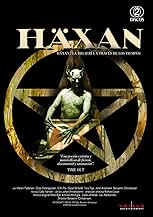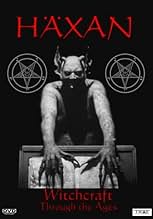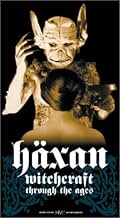NOTE IMDb
7,6/10
18 k
MA NOTE
Documentaire fictif montrant l'évolution de la sorcellerie, depuis ses racines païennes jusqu'à sa confusion avec l'hystérie dans l'Europe moderne.Documentaire fictif montrant l'évolution de la sorcellerie, depuis ses racines païennes jusqu'à sa confusion avec l'hystérie dans l'Europe moderne.Documentaire fictif montrant l'évolution de la sorcellerie, depuis ses racines païennes jusqu'à sa confusion avec l'hystérie dans l'Europe moderne.
Elisabeth Christensen
- En ældre bondekone
- (as Elizabeth Christensen)
- …
John Andersen
- Chief Inquisitor
- (as Johs Andersen)
Emmy Schønfeld
- Marie, the Seamstress
- (as Emmy Schönfeld)
Commentaire à la une
More commonly known as "Witchcraft Through the Ages", this is definitely one of the most bizarre, visually arresting movies of all time, even nearly 80 years later. It starts out as a rather dry documentary, detailing medieval superstitions and folklore while showing ancient woodcarvings of witches and demons in various forms. Then we move on into the dramatic portion of the film. In one scene we see witches concocting potions using the body parts of corpses from the gallows. One witch walks in carrying a bundle of sticks, and undoes the bundle revealing a decomposed human hand hidden inside. Fans of "The Blair Witch Project" should take notice, especially considering that the Danish title of this film is "Haxan", also the name of the movie company that created "Blair Witch".
Director Benjamin Christensen appears as a leering, tongue-wagging Satan, with very realistic makeup. The witches are shown with the Devil and his minions performing various acts of sacrilege and perversion that must have been extremely shocking at the time the movie originally appeared, and would be offensive to many people still. The film was banned for many years because of the depiction of these acts (not to mention the occasional nudity), as well as sacrileges performed by nuns and monks. There are some stop-motion animation sequences (pre-Harryhousen, no less) that are very good, especially for the time. This is a difficult movie to describe. It really is something that you'd have to see for yourself.
The version I am reviewing is actually the re-issue from 1966, with a dubbed-over narration by beat novelist/junkie William Burroughs, and a modern, jazzy score featuring Jean-Luc Ponty. I enjoyed Burroughs' narration quite a bit, but oftimes the music is annoyingly inappropriate. Sometimes it works very well, but most of the time I was wishing for a standard orchestral, or vitaphone, score. A Klezmer score, even, would have been very effective. There are a few different versions available, some with subtitles and an orchestral score. Maybe one of these days they'll come out with a version featuring the Burroughs narration along with a more appropriate orchestral score. That would be perfect. As it is, this an impressive, compulsively watchable film that still goes further than most dare to go, even in these much more permissive times.
Director Benjamin Christensen appears as a leering, tongue-wagging Satan, with very realistic makeup. The witches are shown with the Devil and his minions performing various acts of sacrilege and perversion that must have been extremely shocking at the time the movie originally appeared, and would be offensive to many people still. The film was banned for many years because of the depiction of these acts (not to mention the occasional nudity), as well as sacrileges performed by nuns and monks. There are some stop-motion animation sequences (pre-Harryhousen, no less) that are very good, especially for the time. This is a difficult movie to describe. It really is something that you'd have to see for yourself.
The version I am reviewing is actually the re-issue from 1966, with a dubbed-over narration by beat novelist/junkie William Burroughs, and a modern, jazzy score featuring Jean-Luc Ponty. I enjoyed Burroughs' narration quite a bit, but oftimes the music is annoyingly inappropriate. Sometimes it works very well, but most of the time I was wishing for a standard orchestral, or vitaphone, score. A Klezmer score, even, would have been very effective. There are a few different versions available, some with subtitles and an orchestral score. Maybe one of these days they'll come out with a version featuring the Burroughs narration along with a more appropriate orchestral score. That would be perfect. As it is, this an impressive, compulsively watchable film that still goes further than most dare to go, even in these much more permissive times.
Histoire
Le saviez-vous
- AnecdotesThe Swedish film censors required numerous cuts in the film, before authorizing its release. Among the censored scenes were the closeup of the finger being removed from the hanged man's hand, the trampling of the cross in the witch's sabbath scene, the shot of the oozing infant held over a cooking pot, a closeup of a woman's face while she is on a torture rack, closeups of several instruments of torture being employed, and a shot of a demon embracing a nude woman (all these shots have since been restored to the film).
- GaffesThe skeletal horse-like creature wandering around during the Sabbath clearly is being moved about by a couple of stage hands, hidden under the blanket that covers its "body". The feet of the crew member at the front of the monster are visible in one shot.
- Citations
Title Card: Poor little hysterical witch! In the middle ages you were in conflict with the church. Now it is with the law.
- Crédits fousDirector Benjamin Christensen personally thanks his cinematographer and art director through the opening titles.
- Versions alternativesWitchcraft Through the Ages (1968), the 76-minute version of Häxan, narrated by William S. Burroughs, with a soundtrack featuring Jean-Luc Ponty
- ConnexionsEdited into From Camille to Joan of Arc (1961)
Meilleurs choix
Connectez-vous pour évaluer et suivre la liste de favoris afin de recevoir des recommandations personnalisées
Détails
- Date de sortie
- Pays d’origine
- Langues
- Aussi connu sous le nom de
- Häxan: Witchcraft Through the Ages
- Lieux de tournage
- Sociétés de production
- Voir plus de crédits d'entreprise sur IMDbPro
Box-office
- Budget
- 2 000 000 SEK (estimé)
Contribuer à cette page
Suggérer une modification ou ajouter du contenu manquant

Lacune principale
What is the Japanese language plot outline for La Sorcellerie à travers les âges (1922)?
Répondre
![Regarder Trailer [OV]](https://m.media-amazon.com/images/M/MV5BNWUzNDFkOTAtYTdiZi00M2RiLWJiMjktZmZjM2RkNzNhMzBiXkEyXkFqcGdeQXRyYW5zY29kZS13b3JrZmxvdw@@._V1_QL75_UX500_CR0)
















